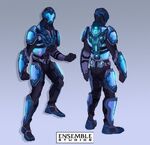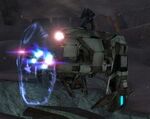- “After exhausting every other strategic option, my creators activated the rings. They, and all additional sentient life within three radii of the galactic center died, as planned.”— 343 Guilty Spark, explaining the fate of the Forerunners
Forerunner is the translated name for the ancient race of enlightened beings that were the creators, builders and activators of the Halo Array, the Arks, Shield Worlds and Requiem, along with the artifacts that were found on the planets Reach, Earth, Sigma Octanus IV, Harvest, Arcadia, Sanghelios, Kholo, and Janjur Qom. All that is known about the Forerunners has been gleaned from these various artifacts. The predecessors of the Forerunners are thought to be another alien race, known as the Precursors. The alien faction known as the Covenant worshipped the Forerunners as gods, deriving much of their technology from Forerunner artifacts found throughout the galaxy, and believing that any who mutilated or destroyed these relics to be heretics.[2]
Known History

A group of Forerunners in combat skin discussing the Flood threat.
- “The Forerunners were a wise, highly intelligent, noble people and with a belief in justice, in peace, they bravely faced the adversary. They sought to sterilize it.”— Cortana on the Forerunners.
Early History
The Forerunners first emerged on the planet of Ghibalb. Described as paradise, this planet became desolate and scoured with radiation after the Forerunners' early experiments in stellar engineering ended in disaster, resulting in a series of novas in the Orion complex.[3]
Eventually, the Forerunners rose up against their creators, the Precursors, although it is unknown how they destroyed them or if any still remain outside of the Milky Way Galaxy[4]
The Forerunners were a very advanced civilization, coming to power after the destruction of the Precursors. The Forerunner believed that the Precursors were responsible for their creation, such as similar physical appearance. Soon after, the Forerunners became the dominant species in the galaxy, their empire spanning over three million fertilized and inhabited worlds. The Forerunners reached their peak before activating the Halo Array around 100,000 years prior to 2552, in the closing days of the Forerunner-Flood war.[5][6]
Being one of three known races ever to achieve Tier 1 technology (the other two being Prehistoric Humanity and the San 'Shyuum) based on the Technological Achievement Tiers measurement, they were only superseded by the mysterious race of beings called the Precursors at Tier 0, evidence of whom have been found on various planets. The fact that the Halos were scattered around the galaxy also hints at the possibility that the Forerunner Empire covered most, if not all, of the galaxy. Their civilization was based around the Mantle, a belief that it was their role to protect all life in the galaxy. They presumably monitored the evolution of other sentient species throughout the galaxy, intervening in ways that ensured their civilizations would follow paths of peace, free of conflict. One such occasion is the devolution of the human empire to prevent further conflict emanating from what they considered a "violent species". The Forerunners themselves were a race almost entirely without conflict, and at some point in their history had reached a point of disarmament, believing they no longer needed weapons in their rule of the galaxy, which ultimately weakened them when the Flood attacked.
The Flood Threat
Later in their history, a Forerunner survey team came into contact with an extragalactic parasite known as the Flood on the planet G 617 g (details of this first contact are unavailable). After this first contact, the Forerunners immediately recognized the great danger that the Flood posed to the entire galaxy and attempted to contain them. However, even they underestimated the potential of the Flood to learn and adapt, believing it to be a non-sentient but highly contagious disease. As such, the attempt to contain the Flood was a failure, as they tried methods more suited to disease control than warfare, trying to contain and quarantine the Flood rather than attack and destroy it outright. They did not start war until it was far too late.[7]
When the Forerunners were unable to contain the Flood outbreak, the galaxy entered a state of war. During the 300 years of the conflict, the Forerunner studied the Flood in labs such as the gas mine located in the atmosphere of Threshold, looking for any exploitable weakness. As the Forerunners soon realized that conventional naval tactics were ineffective against the parasite's onslaught, they developed new weapons and tactics to combat the Flood. The Sentinels were deployed as a means of maintaining the Flood through surgical, localized tactics. The Forerunner fleet command even contemplated using naval battle groups to enact premature stellar collapse within compromised planetary systems, causing supernovae to engulf entire worlds.[8] However, as these tactics proved only to slow, but never stop the expansion of the Flood, the Forerunner leadership realized that the only way to stop the Flood was to deprive it of any and all hosts, thus eliminating its potential to grow. Eventually, the Forerunners created the Halo Array, a weapon of last resort designed to starve the Flood to death by killing all Sentient Beings with enough biomass to sustain them.[9]
At first, the Forerunners were reluctant to use the Array, believing that they should continue to embrace the Mantle and to protect life rather than to destroy it. This led to great stretches of anguished debate and even civil war, but eventually it was decided that the Array was the only means of successfully stopping the Flood threat.[10] The Gravemind managed to convince a Contender-class AI, 05-032 Mendicant Bias, to unite with the Flood. Mendicant Bias soon led his massive fleet in an attack on the "Maginot Line", the final barrier between what the Forerunners could protect and what they were forced to cede to the Flood. At last, the Forerunners exhausted every alternative and activated the Halo Array, killing themselves and all sentient life of sufficient biomass in the Milky Way, with the exception of those species safely placed on the Ark.
According to 343 Guilty Spark, at least the Librarian is alive, and he knows where to find her. After the Array was fired and the Flood had been eliminated, the Forerunners left behind an automated system of automatons, much like the Sentinels, and AIs to spearhead the reseeding of the galaxy with those data logs, embryos, and specimens contained on Sentinel sacrificed themselves in order to activate the array, their last military presence and members of their species defending the Ark until the Didact activated the Halo Array, cleansing the galaxy of the flood.[11]
Description
The Forerunners are quite similar to humans, but also share traits with the San'Shyuum as well. The differences from either of these species is that Forerunners have a pale complexion and black sclera.
Due to Forerunner customarily wear armor or combat skins at all times, it is difficult to determine other natural traits as well. A common trait of these seems to be that it makes Forerunners hover in a standing position.
Forerunner mutation to rates, also affect the characteristics of a forerunner; these traits apparently range from increased height to a additional thumb on each hand.
Forerunner Technology

A Sentinel and a Monitor. Both are Forerunner creations with specific tasks.
Forerunner technology was highly cultivated and progressive. They managed to create solidified surfaces out of meticulous energy, construct a Halo-wide teleportation grid, and create and utilize a number of other advanced machinery. Forerunner machinery consists of many sharp angles of a metallic like crystal reinforced on a molecular level. The Halo Rings themselves, the Micro-Dyson Mark II sphere, which is connected through a portal to the shield world Onyx, and the Ark (Installation 00) are, above all others, the most significant pieces of Forerunner technology. The planet Onyx in particular demonstrates both their ability for engineering on a grand scale, and their near transcendent grasp of Slipspace technology. The Forerunners can also "devolve" a species back to a primitive state. It is unknown how much of their technology is based on the technology of the Precursors, if any.
Covenant Luminaries (which are actually stolen Forerunner equipment designed to detect other Forerunner objects) can detect Humans, previously mislabeled as "Forerunner Artifacts", leading to the initial Human-Covenant contact which sparked a seemingly endless war. Ironically, the Covenant worships the Forerunners but fight Humans, who have been confirmed as Forerunner descendants by the Oracle. The idea of living Forerunners in the Galaxy (described by the Oracle as Reclaimers) terrified the Covenant leadership. In an attempt to protect their religion the Prophets of Truth, Regret, and Mercy concealed the true identity of Humanity to the rest of the Covenant and deemed them as heretics, thus sparking the Human-Covenant War. Huragok are the only known Forerunner creation to be both non-robotic and to be part of the Covenant.
Forerunners have the technology to reproduce entire individuals from encoded DNA/RNA/silicon samples in data streams. This was mentioned in the Bestiarum: "DNA/RNA/Silicon samples are encoded in this data stream. Reproduction of individuals for analysis is prohibited by this facility."
The Forerunners appeared to be genetically related to the humans, which can be corroborated by the Iris Server-05 message about the humans providing "answers" to the Forerunner's own "mysteries", and Mendicant Bias's own declaration in Halo: Contact Harvest. This also explains why the Prophets ordered the Covenant to exterminate humanity, knowing that they are the Forerunner's designated heirs and would undermine their power. Halo 3 and the Halo Encyclopedia provided further evidence of this as well.
Weaponry

A group of Forerunner soldiers firing light-based weaponry.
Forerunner constructs and sentries use a broad variety of weapons, typically high-powered energy beams. These weapons proved to be very effective when battling the Flood, burning Flood forms to the point that they cannot be revived by their compatriots. The Forerunners have also proven to be able to merge beams together into one stream to amplify its power. The Forerunners installed and constructed these intricate beam weapons inside their paradigm Arrays, allowing them to build an army of machines to battle the Flood without sending any Forerunner to the front lines. Forerunners evidently made active use of plasma weaponry as well; the Covenant's own weapons and technology are solely based on Forerunner artifacts. It could also be that these are Forerunner light-based energy weapons, yet the Covenant have not yet been able to unlock their full power, much like the Dreadnought - and are only able to produce plasma due to lower energy output.
The Sentinels wield orange-colored directed energy beams, used primarily for fighting the Flood. Sentinel Majors however, have a more powerful and accurate version of the beam, which sports superior energy output, at the cost of overheating issues. These more advanced energy beams are colored blue. All variants of these Sentinel Beams can be wielded by Humans and certain Covenant races.
Meanwhile, Enforcers are equipped with multiple packs of small grenades, or mortar-like explosives launched over the top of their shield. The Enforcer also boasts a pair of Pulse beams, which fire clusters of smaller red Needler-like projectiles or bolts of energy at an incredibly high rate of fire. These pulse beams are primarily used against infantry at close range. These mammoth constructs also seem capable of lifting even tanks, using some sort of magnetic or anti-gravity grapple, before crushing the target between their massive 'arms'. The Constructors' repair beam can also be considered a weapon, but with minimal damage output.
The Sentinels of Onyx had significantly more powerful weaponry. They were described to be a sphere surrounded by three floating "booms", or small pieces of armor that possessed powerful energy shields which would suddenly "pop" into place in order to deflect objects moving at high velocities.[12] Their shields are not activated by slow-moving objects, however - Team Saber used this to their advantage to destroy one of the Sentinels with rocks. Their energy weapons are described as a single, slow-charging, golden beam that could melt straight through the SPI armor of the SPARTAN-IIIs. SPARTAN-058 had also noted that one blast from these weapons was enough to drain the shields of her MJOLNIR Mk V armor. The Onyx Sentinels also have the ability to combine for different purposes, such as exponentially increasing their combat capabilities, or for large-scale excavation. One formation of these combined Sentinels was able to easily destroy two Covenant destroyers. However, it should be noted that the second Covenant Destroyer was caught off guard after a Slipspace jump, and the first one had its energy shields down in a gesture of peace, trying to initiate contact with the Forerunner constructs.
A concept art of Forerunner combat skin.
The Forerunners also constructed Automated Turrets that fire blue beams similar to those of Sentinel Majors. These turrets themselves resemble stripped-down Sentinels, and hover in mid-air, tracking enemy targets, but are otherwise immobile.
In Halo 3, it seemed that even the Monitors had the ability to defend themselves against the Flood using a focused beam similar to the Sentinel's beam, but much more powerful. 343 Guilty Spark displayed this ability in Floodgate, The Covenant, and Halo. The weapon was capable of draining the shields of a SPARTAN-II in one blast and mortally wounding Sergeant Major Avery Johnson. It is also quite odd and puzzling as to why 2401 Penitent Tangent didn't use this ability against the Gravemind in Halo 2. It is assumed that the Gravemind is likely to have damaged 2401 Penitent Tangent when he captured the Monitor, disabling its beam weaponry. It could simply be that it was not equipped with one, although this is highly unlikely due to the importance of the monitors to ensure the Halo installation's upkeep.
Forerunners themselves used advanced exoskeletons called combat skins and wielded an as yet unnamed beam weapon.[13]
Forerunner Armor
- Main article: Forerunner Armor
Art and Architecture

The Library, a classic example of Forerunner architecture.
Forerunner architecture is noted mainly for being large-scale and geometric in style, with a semi-triangular theme being the most commonly observed design. The Forerunners were highly skilled at creating natural-looking habitats, such as those of the Halo rings, which tend to be very elaborate, with numerous extrapolations of the basic design of a construct appearing to be purely decorative. In addition, the structures were engineered to compliment the natural landscape, as opposed to the modern idea of replacing it. That said, their distinctive beauty are not restricted to Halo Array network. The Aztec-esque stones of Cote D'Azur, the arches and weathered inscriptions of Sigma Octanus IV, the intricate caverns and three-kilometer holographic dome beneath ONI's Reach complex, the ancient stepping-stones of the Grunt's homeworld, and the Forerunner City discovered in the depths of the human-inhabited Onyx, all display the Forerunner's innovative architectures. Most Forerunner architecture is constructed with a special type of metal that resists deterioration, bullets, plasma bolts and fire, as made evident by Forerunner structures standing in pristine condition 100,000-150,500 years after they were built. However their resistance to plasma fire is limited; in Halo: Ghosts of Onyx the Elites blasted a hole in a Forerunner wall with plasma weapons. In Halo 2, Sgt. Avery Johnson destroyed the door to the control room of Delta Halo with a Scarab. It should also be noted that the Flood attempted to melt a metal gate in a tunnel using Covenant weapons in order to attack UNSC troops on Installation 04. Other structures are constructed out of traditional materials, such as chalcedonic quartz, which does not preserve nearly so well. These structures employ complex geometric shapes that appear to operate in dimensions higher than human understanding can comprehend.[12] The Forerunners also decorated the interiors of their structures with a complex web of engraved straight lines and applied decorative touches and designs to nearly everything that they built, from structures to weapons. Even the Sentinel robotic drones possess small holographic Forerunner script around their "eyes".
Forerunner architecture distinguishes itself from Covenant structures in that they incorporate heavy use of geometric angles, usually at either extremely sharp degrees (as the Forerunner buildings are usually triangular), or at forty-five degree angles, most notably seen in Halo: Combat Evolved . Originally, the ideas and concepts on Forerunner structures and technology was that it would be sleek and curved to give it an advanced feel. However, Bungie wanted the structures to feel as if they could stand the test of time and redesigned them to be solid and monolithic. The smooth, near-organic design would later be adopted by the Covenant in their architecture, although they did not adopt the Forerunner tradition of decorating their structures with glyphs. In Halo Wars the Forerunner counting system is used to open and close portals on the last level.
Forerunner Astroengineering
- Main article: Astroengineering
While the Forerunners' architectural and technological prowess is legendary among the Covenant and UNSC, their masterpieces also extended to the fields of stellar engineering. At least three Forerunner sites, the Shield World[12] Onyx, the Ark,[14] and the Micro Dyson Sphere that holds the Apex, made use of suns where none should exist. The Shield World existed permanently in Slipspace, where solar systems outside of a Dyson Sphere cannot exist, and the Ark was located far outside of the galaxy where galactic material would have been insufficient to form the sun that illuminates the Ark. The sun at the center of the Dyson Sphere where the Apex was housed was abnormally small, in order to accommodate the planet-sized Dyson Sphere. Whether these suns are artificially engineered or simply moved from another star system by the Forerunners is unknown: either would have been an enormous technological achievement. Another known Shield World is the planet discovered by the Spirit of Fire . This world had an outer crust like Onyx, but its inner Dyson sphere was accessed through a long narrow tunnel hidden under one of the planets oceans. Once through the tunnel, the Spirit of Fire had to pass through several "cleansing rings" in order to make it to the center of the planet. This Dyson sphere, unlike the Onyx Dyson sphere, was not separated in slipspace but was actually constructed on what appeared to be the hollowed out interior of the planet. This sphere seemed to have had an artificially created sun like the one on the Ark.
The Ark is confirmed to be artificial, due to its unnatural "flower head" shape. It is likewise unknown if these are the only stellar engineering achievements the Forerunners made. However, it is clear that manipulation of slipstream space allowed the Forerunners to transport and position these structures throughout the galaxy.
| |||||||||||||||||||||||||||||
Forerunner Glyphs and Symbols
An image of the Iris Forerunner icon. It is the zero of Forerunner Numbers.
- Main article: List of Forerunner Symbols
| This section requires expansion. |
The Forerunner glyphs seem to be based on a series of circular, complex shapes. The glyphs have been inscribed almost everywhere Forerunners were once present, from different areas on Earth, to the Halos. They were also known to inscribe these glyphs and symbols onto their weapons, machinery, and clothing; a practice that the Covenant also copied, evident with the Forerunner symbols placed on the hilt of the Energy Sword and on the Sangheili Combat Harness. The only Forerunner glyph that has been translated is the "reclaimer" symbol, which also happens to be the logo of the Marathon series and a recurring image in the Halo universe. Though it was originally misinterpreted by the Covenant to mean "reclamation"; this mistake was brought to light by the fragment of Mendicant Bias aboard the Forerunner Dreadnought that was located inside of High Charity at the time.
Religious significance
The Covenant consider the Forerunners as gods and referred to them as the "Ancients". The Covenant believed that the Forerunners disappeared from the galaxy after the Halo Array elevated the Forerunner to a state of trans-sentient godhood. As such, they have appropriated many Forerunner technologies and artifacts, and such searching led to the Covenant coming to Harvest in the first place, therefore beginning the Human-Covenant war. The most holy of these artifacts, the Sacred Rings or Halo Installations, were seen as the means by which the Forerunners ascended into divinity. The Covenant believed themselves to be the chosen inheritors of the Forerunners' legacy, and by locating and activating the Halo Array, the Covenant believed that they too could follow the Forerunners into godhood. This is referred to as the "Great Journey" by the Covenant races.
Trivia
- The Forerunners show some similarities (their highly advanced technology and the fact that they mysteriously vanished) to the Jjaro, a race of aliens from an old previous Bungie game, Marathon. The concept of a highly advanced extinct race leaving technological relics behind is not a new concept and is indeed a fairly common element of science fiction of all media, from books and video games to films.
- The Forerunners were the main focus of the alternate reality game, Iris.
- It was announced that a trilogy of books based on the Forerunners' culture and their war with the Flood will be written by Greg Bear.
- In Halo, the last campaign mission in Halo 3, there is a cutscene in which a rampant 343 Guilty Spark says to John-117; "You are the child of my makers. Inheritor of all they left behind. You are Forerunner." This, among other things, has led to many fans to conclude that Humanity and the Forerunner are one and the same. However, the Terminals show that the "Librarian" was on Earth, discovering early modern humans 100,000 years ago, indexed them, and built a portal to Installation 00 to send them there. This makes it more likely, in accordance with known Forerunner mythology, that the Forerunners merely intended humanity to be their successors, and likely did something to the species as a whole to allow Forerunner technology to recognize them.
- It is revealed in Halo 4 that John-117 is the direct result of very careful planning and precise modification of Humanity by the Librarian (right down to his Mjolnir armor and his relationship to Cortana) as a means to defeat her vengeful husband. This could prove true Guilty Spark's comment that John-117 is the "child" of his makers.
- Forerunner is also a rank in Halo: Reach.
- Forerunners have a significant appearance in Halo 4 as the main antagonists,
- The Forerunners upheld the Mantle and therefore only ate a vegetarian diet, as it was against their beliefs of the Mantle to harm other living beings.
- In Halo: Ghosts of Onyx and Halo: Glasslands, three pods are located by characters within these works that might contain yet more Forerunners, who have survived by various means.
- Early concepts of the Forerunners' combat skin bears slight resemblance to the robotic Geth from Mass Effect.
- The Didact and the Librarian are the first Forerunners to be seen not wearing a mask or helmet.
Gallery
Sources
- ↑ Halo: Cryptum, page 76
- ↑ Halo: The Flood, From the experiences of John-117, the Master Chief, the Covenant do not fully understand the Forerunners. This is evident when they mistranslated the Glyph "reclaimer" as "reclamation"
- ↑ Halo: Cryptum "Page 222"
- ↑ Halo: Cryptum "Page 342"
- ↑ Halo 2, The Great Journey
- ↑ Halo 3 Limited Edition - Bestiarum
- ↑ Ascendant Justice's analysis on the terminals - Voice From The Tomb
- ↑ Halo Encyclopedia, page 169
- ↑ Halo: Combat Evolved, 343 Guilty Spark
- ↑ Halo Encyclopedia, page 172
- ↑ Cite error: Invalid
<ref>tag; no text was provided for refs namedReferenceA - ↑ 12.0 12.1 12.2 Halo: Ghost of Onyx
- ↑ Halo Legends:Origins
- ↑ Halo 3, The Ark and Halo Levels
External links
- Forerunner Symbolism - An article on Forerunner symbols.
- A Comprehensive Research over the Forerunners.
| ||||||||||||||
| ||||||||||||||





















